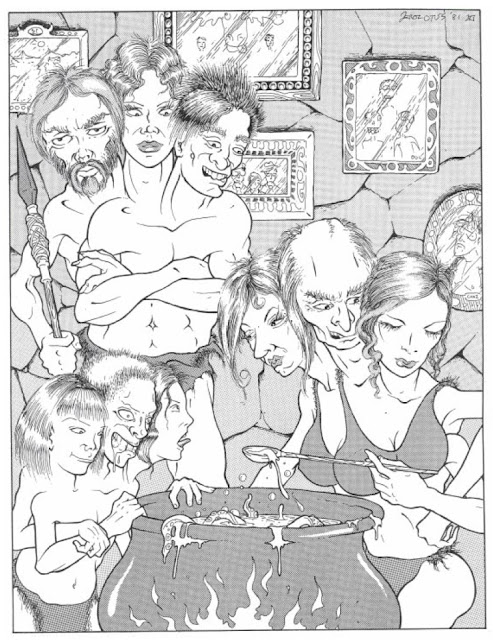 |
| Original drawing by Jeff Easley / Coloring by Sorvan |
There are myriad subjects I wanted to touch upon in regards to playing first edition Gamma World, so I will just chip away at my notes as I feel inspired. One of the most visceral pleasures I had as a GM to a table full of fledgling GW players, was the fact the all the monsters would be new to them and completely mysterious. Hell, after close to thirty years, the monsters were pretty "new" to me as well! Each random encounter on the road would fill the party with dread (as is fit for any D&D-like RPG), but also a sense of wonder because they would be trying to figure out just what the fuck that crazy sounding beast was. The sensation kind of mixes together the two of the primary elements of RPGs... battle and exploration at the same time. I love all the classic D&D monsters, but to a certain extant, everybody at the table knows what you are getting when you encounter a goblin, or ghoul, or dragon. But what the hell are up against when the GM is describing a horl choo, a barl nep, or a yexil? Even the names are completely alien and beyond deciphering. I remember as a kid I was kind of tripped up by those weird names and the fact there were no monster illustrations (for the most part), but these days all that is fundamental to my enjoyment of the game.
I tried to stick to the essential power descriptions as listed in the rulebook (occasionally allowing for some ideas from the second edition rules as well), no matter how strange, and let that flavor my impression of the creature. For example, the arks have the weather control ability that didn't seem to mesh well with their other powers, but after some thought I decided that the arks were these witchy wolf-people that lived on the fringes of civilization, feeding on humans and spoiling the crops unless the humans were able to broker terrible deals with them. I also allowed the arks to summon the occasional lightning bolt with their weather abilities, just to make them more fearful and devastating.
On the other hand, there were some descriptions that proved too tortured (or boring) for my rationalizations as is... mainly with the shapechange ability of a few creatures. For example, the ability of cren tosh to morph into "any lizard" (boring), or the similar ability of fleshin to morph into sleeth. (Why sleeth? The two creatures are not overly similar, and sleeth are much more sophisticated and intelligent than fleshin.) I decided to keep as close to the rules as written as I could while injecting a small dose of rationalization into both those monsters. Basically, I made them the weird juvenile forms of the mature sleeth, the cren tosh being the males and the fleshin being the females. Each has the capacity to mimic the adult sleeth, although at a much diminished capacity... it's more of a disguise than anything else. Who knows what sort of strange and mysterious process finally transforms these adolescent creatures into full-blown sleeth? The cryptic sleeth guard the secrets of their culture well.

